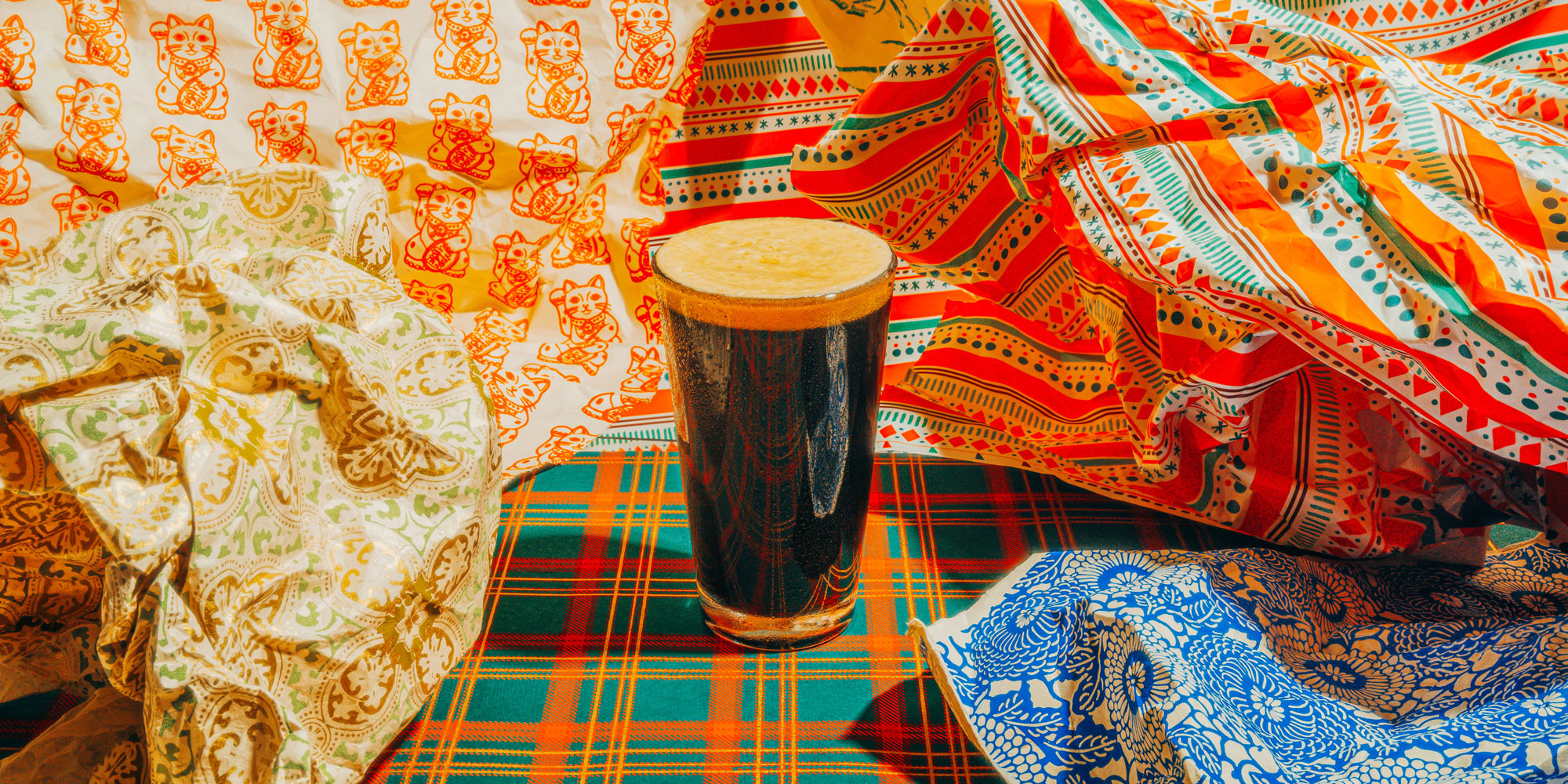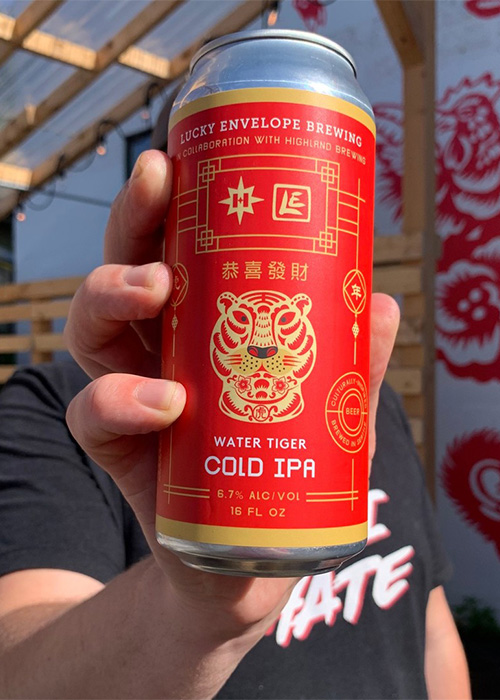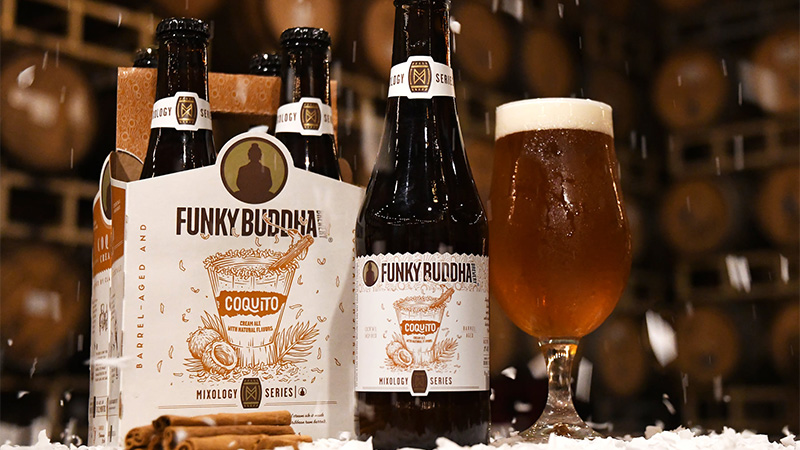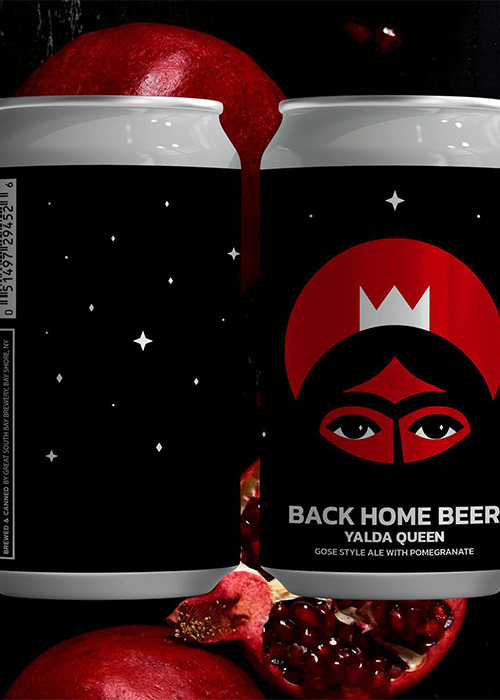
Over the centuries, societies have marked the winter solstice and surrounding days with celebrations and something to drink. Ancient Romans fueled their hedonistic Saturnalias with mulsum, a mixture of honey and wine, and the Inca Empire’s Inti Raymi festivities featured chicha, a fermented corn beverage.
During Shab-e Yalda, Iranian families gather to read poetry and snack on watermelon slices and pomegranate seeds. The red color symbolizes the “glow from the sun,” says brewer Zahra Tabatabai, the founder of Brooklyn’s Back Home Beer. She creates beers inspired by her Iranian heritage, including the Sumac Gose and a lager sprinkled with Persian blue salt.
To celebrate Yalda, she designed a pomegranate gose with a striking label from Iranian artist Mina M. Jafari featuring a woman wearing a pomegranate-like crown. Released in December, Yalda Queen centers a different holiday on the beer shelf, broadening the idea of seasonal celebrations. “For me, it’s very important to spread Persian and Middle Eastern culture and tradition,” Tabatabai says.
Christmas-themed beers prance across release calendars, trampling competition like snow beneath reindeers’ hooves. But America isn’t one nation under Kris Kringle, indivisible, with Great Lakes Christmas Ale for all. As the country’s craft breweries grow increasingly diverse, so do the beers toasting to a broader range of wintertime holidays.
Chinese-American breweries are turning to yuzu and unique teas to create beers for Lunar New Year, while Puerto Rican breweries are taking seasonal cues from rum-laced Coquito. Krampus-themed ales are a scary little trend, and other breweries are embracing winter by dunking red-hot pokers into beer. ’Tis the season to sip something unexpected.
Going Beyond Christmas for New Customers
I spent a sort-of Jewish childhood in the suburbs surrounding Dayton, Ohio, hardly a hotbed for celebrating Hanukkah in the late 1980s. We made latkes and lit our menorah, but I also drank eggnog and envied our neighbors’ twinkling Christmas lights, too young to comprehend cultural assimilation.

Barry Chan grew up in rural Pennsylvania, where his family de-emphasized his Chinese heritage. “My parents were definitely high on the assimilation side,” he says. “I did not learn Mandarin or Cantonese.” As a founder of Lucky Envelope Brewing in Seattle, Chan is reconnecting with his culture through beers that champion Chinese ingredients and traditions, including Lunar New Year.
Each year, Lucky Envelope — named after the Chinese tradition of gifting red envelopes containing money for luck — brews Lunar New Year beers that might include an imperial porter flavored with fragrant pandan leaves; a sour ale seasoned with Thai basil and lychee; or Mijiaya Historic Chinese Beer. It contains lily flowers, millet, and other ingredients discovered at a 5,000-year-old archaeological dig proving early Chinese brewing’s existence.
“People come out every year just to try it,” says Chan, who releases Mijiaya at the brewery’s annual Lunar New Year celebration, which draws a large Asian-American audience. “It’s our most popular event.”
Next year marks Lucky Envelope’s eighth anniversary — a particularly lucky number in Chinese culture — and the brewery is planning an eight-day celebration around Lunar New Year, which falls on Jan. 22. The blowout will feature a half-dozen beers, including Lucky Envelope’s annual Zodiac-inspired collaboration with Highland Brewing Company, a fellow Chinese-American brewery based in Asheville, N.C.
In 2020, the breweries used berry-like Lotus hops to make Metal Rat hazy IPA, followed by 2021’s Metal Ox juicy IPA featuring lychee rose black tea, and last year’s honeybush tea–infused Water Tiger cold IPA. “There’s always an ingredient and flavor profile that’s inspired by Chinese culture,” says Highland president and CEO Leah Wong Ashburn.
For the forthcoming Year of the Rabbit, the breweries are teaming up for a yuzu pilsner, and Highland will also host a festive, family-friendly Lunar New Year party. “I’m appreciative that we’ve been able to find each other and do something that raises a rare voice in craft brewing,” Ashburn says.
Eggnog is a common holiday treat, sprinkled with nutmeg and ideally spiked with strong and fortifying booze. Breweries have made numerous eggnog beers (and even “seltzer nog”), but now they’re riffing on the Puerto Rican Christmas tradition of Coquito.

At Funky Buddha in Oakland Park, Fla., you’ll find Coquito in the form of a rum-barrel-aged imperial cream ale. Magnify Brewing of Fairfield, N.J., created its Coquito by finishing a bourbon-barrel-aged sour ale with coconut cream, cinnamon, and vanilla ice cream.
At Wynwood Brewing in Miami, founder Luis Brignoni leans on his Puerto Rican heritage to create Coqui-to, a strong milk stout seasoned with cinnamon, coconut flakes, nutmeg, vanilla beans, and charred oak chips. “It’s a family tradition that I wanted to turn into a beer,” Brignoni says of Coqui-to, just released on Black Friday.
The more people that brew a Coquito beer, the merrier this season might be. “It’s great to see so many people do a take on Coquito,” Brignoni says. “Our little island can have a big cultural impact.”
Crafting New Holiday Drinking Traditions
For most, the holidays are synonymous with excess. Go on, grab more pie and imperial stout! But plates and glasses empty in the New Year and resolutions take their place, leading breweries to rethink release schedules for beers. One such beer is Hopslam, a honey-infused 10 percent IPA from Bell’s Brewery.
“Ever since I can remember it’s always been released in January,” says Scott Powell, the marketing director for Bell’s, headquartered in Comstock, Mich. “We wanted that date on the can to be after Jan. 1 so there was no doubt that people were getting the freshest Hopslam.”
But in recent years, fans wrote in with news of restraint and resolutions, cutting back on Hopslam consumption during its release month — Powell himself included. “I’ve been doing Dry January for the last couple of years,” he says. So this year, Bell’s moved up Hopslam’s debut month to October, slotting it into the holiday window. “Indulge in your eggnog, Hopslam, and everything else around the holidays,” Powell says.
Some parents sneak bites from cookies for Santa Claus, while other adults might favor cold beers celebrating his horned demonic counterpart, Krampus, who punishes naughty children. The folkloric European creature is finding a receptive home at breweries, with Krampusnacht celebrations at Notch Brewing in Brighton, Mass., and Marz Community Brewing in Chicago, where attendees sipped fruity Krampbiscus ale while listening to a marching band.
The Black Abbey Brewing Company opened in Nashville in 2013 with a focus on European-influenced American craft beer such as Belgian-style abbey ales and a brown ale brewed with U.S. hops.
When the brewery brainstormed its first holiday beer in 2014, cinnamon, nutmeg, and spices were a nonstarter. Instead, Black Abbey created a dark bock called Krampus Nacht, sticking the creature’s terrifying head on the label.
The beer is released at the end of November and regularly sells out before Dec. 31. As an unspiced strong lager, “it can also appeal to people that don’t know about Krampus,” says president and co-founder Carl Meier. And if the beer lingers into the new year, “people can still drink it in January and not feel like they’re behind the times.”
The holidays sort people into specific cultural and religious tribes with idiosyncratic traditions that vary across regions and families. Commonalities aren’t easy to come by, save for one constant: colder weather in the winter.

Last year, Primitive Beer in Longmont, Colo., started hosting “hot bier” pop-ups that featured a glühbier made with its spontaneously fermented beer flavored with honey and spices. Attendees could also buy smoked Baltic porters, British-style bitters, dark lagers, and other malt-rich beers that were finished by plunging a flaming-red poker into them. The process knocks out carbon dioxide, softening the beer, and creates a deeper caramelized character and mousse-like head.
“Being able to celebrate larger changes of seasonality gets me excited,” says co-owner Brandon Boldt.
This winter, Primitive plans to host monthly events, roughly between the winter solstice and spring equinox, giving people a reason to bundle up and gather for warm beer and even warmer conversations. Adds Boldt: “If the upsetting part of the Northern Hemisphere winter is colder weather and the daylight becoming shorter, then this is our response: OK, but at least you have hot beer.”
The article For Breweries Across the Country, Holiday Releases Mean More Than Christmas appeared first on VinePair.

